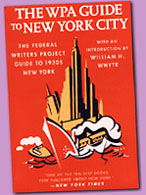
Title: The WPA Guide to New York City
Authors: The Federal Writers Project
Year: 1939 (reprinted 1992)
Publisher: The New Press/W.W. Norton
Price: $15.95 US
Review by: Randy Williams
|



Title: The WPA Guide to New York City
|

 |
This week's Literatour transports the reader to the Manhattan of modern-day films by Woody Allen, presenting a great list of sights immortalized by Allen's films which can be checked out on the cheap. But what of the New York City of Woody's youth? He was not always a world-famous film director with a luxurious apartment on the Upper West Side. In fact, he was born ordinary Allan Stewart Konigsberg in working-class Brooklyn on December 1, 1935. Many of his films take a comically wistful look back at his childhood days in Brooklyn (notably 1977's "Annie Hall") and his fascination with the splendor of Manhattan (especially the magical scene in 1987's "Radio Days" in which a young "Woody" character sees Radio City Music Hall for the first time). The problem is, much of the New York City of the 30s and 40s is long gone. Scores of historic buildings were demolished in the 50s and 60s to make way for new high-rises, leaving no way for the modern visitor to New York to experience the city of the director's formative years.The good news is that such a visitor can uncover a wealth of information about that vanished metropolis in "The WPA Guide to New York City." First published in 1939 to coincide with the grand opening of the World's Fair, this is a magnificently sprawling 700-page book assembled by the Federal Writer's Project (part of the Works Progress Administration created by FDR's New Deal). The Project found work for unemployed writers, photographers and artists during the depths of the Depression by assigning them to chronicle American life in all its settings and forms, from the rat race of the largest urban centers to the folklore-steeped traditions of backwoods Appalachia. These were not hacks pounding out travel guides but real artists spinning descriptions that are visceral, incisive, and often beautifully lyrical and poignant.
The New York guide is almost certainly the best of the lot, and the writers cover a huge number of locations in all five boroughs with honesty and a fine eye for historical detail. The reader learns, for example, that the Bowery -- a slum at the time of the writing -- had once been the center of the city's theatre district, particularly known for traditional Yiddish dramas. Entries on rail stations and police precincts jump from the page with not only detailed descriptions of the architecture but also of the bustling activity the buildings contained. The book further indicates the human character of the city through colorful portraits of New Yorkers from all walks of life. In addition to the text, there are hundreds of prints and photographs, detailed maps, and guides to restaurants and attractions with 1939 prices still intact (a room at the Plaza Hotel went for $7.50, while day-long sight-seeing tours were fifty cents). Part literature, part history, and part travel book, "The WPA Guide" is an invaluable resource for understanding the New York City that first captured Allen's imagination and that, even in the bleakest days of the Depression, remained a shimmering beacon of opportunity where all things seemed possible.
"The Empire State Building, 1250 feet high, is the tallest structure in the world. The great limestone and steel structure has been called a monument to an epoch -- the boom years from 1924 to 1929. The building became, as those who envisioned it promised, an internationally known address. The superb main shaft of the Empire State rises in an almost unbroken line out of the broad five-story base that covers approximately two acres adjoining Fifth Avenue. Atop the shaft, at the eighty-sixth floor level, is the 200 foor observation tower -- a sixteen-story glass and metal extension shaped like an inverted test tube buttressed by great flaring corner piers...A peculiarity of the Empire State building is that the windows, instead of being set back into the wall, appear to be flush so that the effect is one of a continuous wall. By this expedient, the architects not only avoided gouging the wall into something resembling an immense waffle iron, they also eliminated the need to trim the stone around the openings, thus saving much time and money in construction. The color scheme of the building, though losing its remarkable first "blond" tone through weathering, is spectacular in early and late sunlight. The aluminum spandrels and the soft-textured limestone are tinged with gray and lavender, and the silvery sheen of metal on the walls creates an effect of airy lightness."
(pp. 319-20)
When "The WPA Guide" was first published in 1939, "The New York Times" called it "useful, broadly informative, and amazing." In 1995 the same paper named it "one of the ten best books ever published about New York." "The Guide" was reissued in 1992 by the Free Press, a non-profit publisher devoted to making available at a reasonable price books which "should be in print." The new edition features an excellent introduction by William Whyte which adds layers of perspective to the enjoyment of the work as a whole. "The Guide" is a landmark volume and a steal at $15.95. In addition to its considerable literary and historical merits, the book can still be a terrific resource for sight-seeing -- after all, a huge number of these places are still extant. There are scores of NYC travel books for tourists, but using this one affords a unique opportunity to see two New Yorks at once -- the physical City That Never Sleeps and the spectral city that is no more, the one which inspired the Federal writers to speak so eloquently of "the heroism of urban life."N.B. "The WPA Guide to New York City" is available on the Web in paperback from amazon.com.
Have you read this book? How many wrenches would you give it? (The more wrenches, the better a Tool for Thought it is.)
Tripod members give this book 4.0 wrenches so far.
You can also read and rate more of Tripod's Tools for Thought.
Map | Search | Help | Send Us Comments